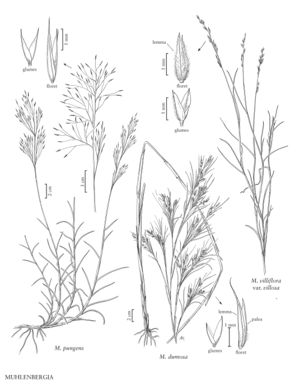Difference between revisions of "Muhlenbergia pungens"
FNA>Volume Importer |
FNA>Volume Importer |
(No difference)
| |
Revision as of 19:24, 24 September 2019
Plants perennial; rhizomatous, not cespitose. Culms 10-70 cm, decumbent below; internodes cinereous-lanate, glabrous, or scabrous for most of their length, always cinereous-lanate below the nodes. Sheaths longer than the internodes, cinereous-lanate below, glabrous and smooth or scabridulous distally; ligules 0.2-1 mm, densely ciliate, obtuse, with lateral lobes; blades 2-8 cm long, 1-2.2 mm wide, flat to tightly involute, scabrous abaxially, hirsute adaxially, stiff, pungent. Panicles (7)8-16(19) cm long, (2)4-14 cm wide, open; primary branches 1.5-8 cm, capillary, straight, lower branches diverging 70°-90° from the rachises in mature plants, often appearing fascicled in immature plants; pedicels 10-25 mm. Spikelets 2.6-4.5 mm. Glumes equal, 1.2-3 mm, purplish near the base, smooth or scabridulous distally, 1-veined, acuminate or acute, unawned or awned, awns to 1 mm; lemmas 2.6-4.5 mm, lanceolate, purplish, scabridulous distally and on the margins, apices acuminate, awned, awns 1-1.5(2) mm, straight; paleas 2.6-4.5 mm, lanceolate, glabrous, acuminate, 2-awned, awns to 1 mm; anthers 1.8-2.6 mm, purplish. Caryopses 1.8-2.5 mm, fusiform, brownish. 2n = 26, 42, 60.
Distribution
Colo., N.Mex., Tex., Utah, Nebr., S.Dak., Ariz., Wyo.
Discussion
Muhlenbergia pungens grows in loose sandy soils near sand dunes to sandy clay loam slopes and flats in desert shrub and open woodlands, at elevations of 600-2500 m. It is known only from the western and central contiguous United States.
Selected References
None.
